BA317 Taxation Law: Evaluating Goods and Services Tax in Australia
VerifiedAdded on 2023/06/11
|8
|1618
|347
Report
AI Summary
This report provides an analysis of the Goods and Services Tax (GST) in Australia, examining its objectives, history, and effectiveness. It discusses the Australian Consumer Law (ACL) and its role in protecting consumers, as well as the fundamental principles of tax policy, including efficiency, equity, simplicity, neutrality, and certainty. The report also outlines the history of Australia's tax measures and reviews key reforms. It evaluates the effectiveness of the GST in meeting its objectives, referencing the Henry Taxation Review and proposed changes to the Australian taxation system. The document concludes by emphasizing the importance of both vertical and horizontal equity in the Australian taxation system.
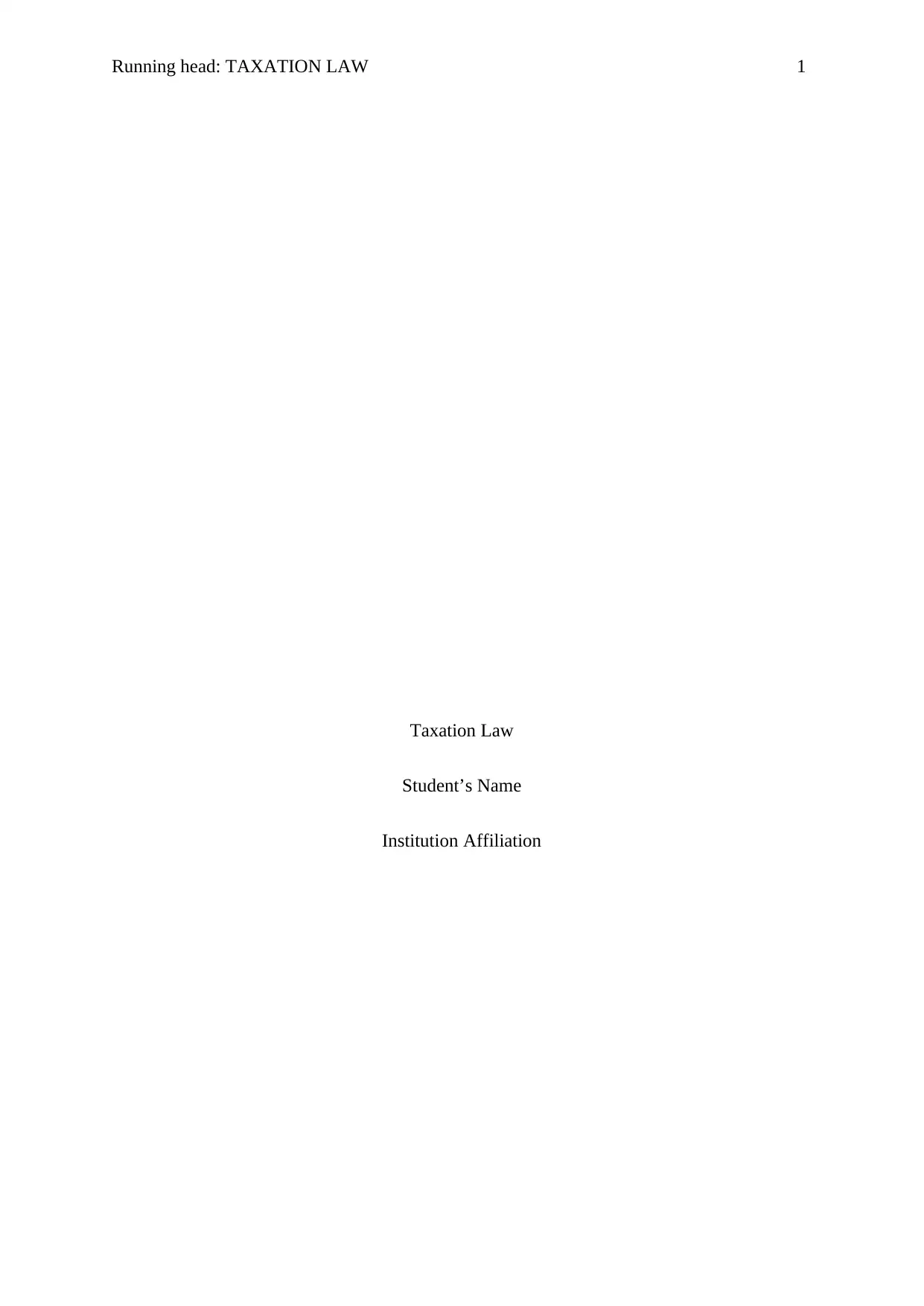
Running head: TAXATION LAW 1
Taxation Law
Student’s Name
Institution Affiliation
Taxation Law
Student’s Name
Institution Affiliation
Paraphrase This Document
Need a fresh take? Get an instant paraphrase of this document with our AI Paraphraser
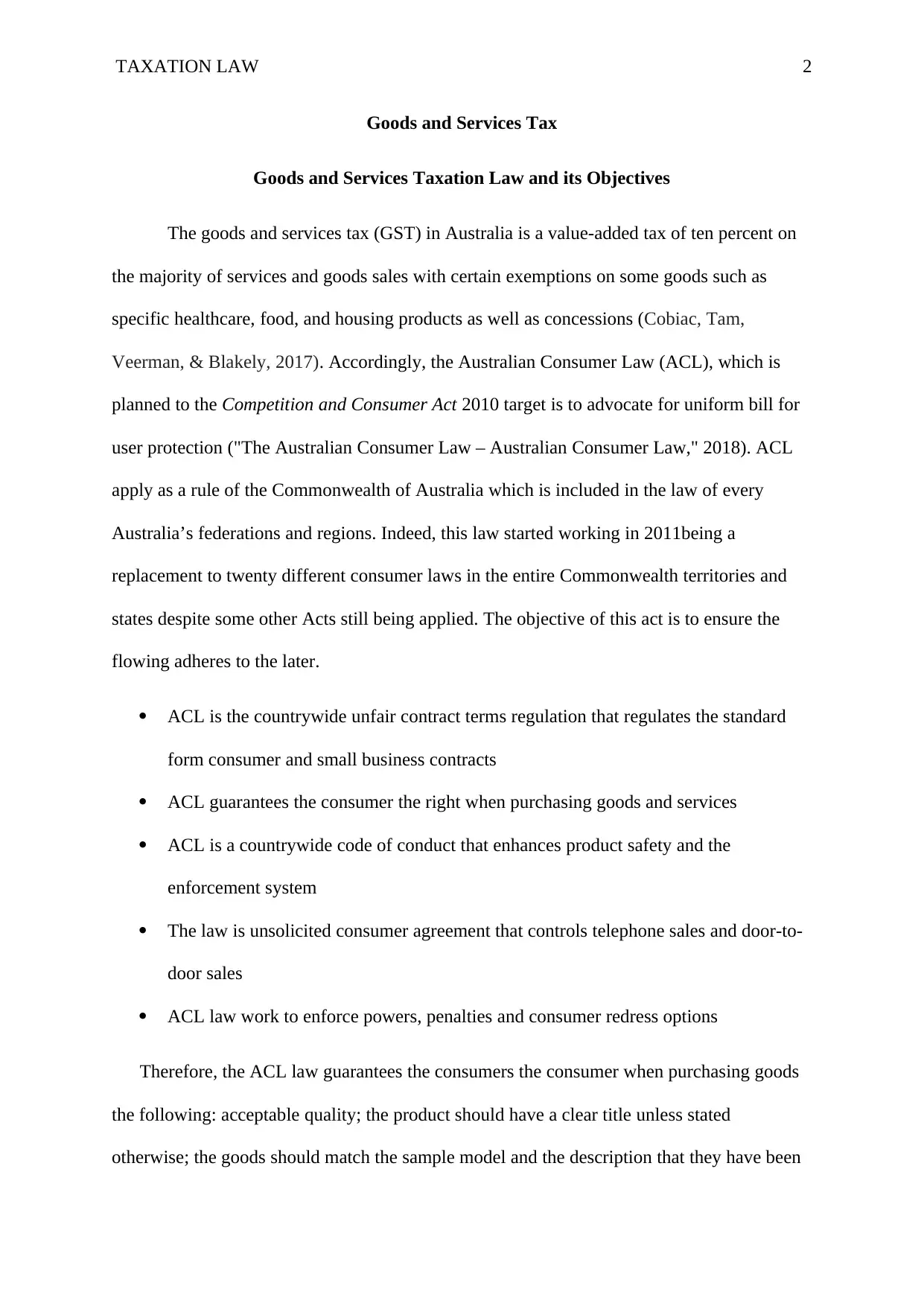
TAXATION LAW 2
Goods and Services Tax
Goods and Services Taxation Law and its Objectives
The goods and services tax (GST) in Australia is a value-added tax of ten percent on
the majority of services and goods sales with certain exemptions on some goods such as
specific healthcare, food, and housing products as well as concessions (Cobiac, Tam,
Veerman, & Blakely, 2017). Accordingly, the Australian Consumer Law (ACL), which is
planned to the Competition and Consumer Act 2010 target is to advocate for uniform bill for
user protection ("The Australian Consumer Law – Australian Consumer Law," 2018). ACL
apply as a rule of the Commonwealth of Australia which is included in the law of every
Australia’s federations and regions. Indeed, this law started working in 2011being a
replacement to twenty different consumer laws in the entire Commonwealth territories and
states despite some other Acts still being applied. The objective of this act is to ensure the
flowing adheres to the later.
ACL is the countrywide unfair contract terms regulation that regulates the standard
form consumer and small business contracts
ACL guarantees the consumer the right when purchasing goods and services
ACL is a countrywide code of conduct that enhances product safety and the
enforcement system
The law is unsolicited consumer agreement that controls telephone sales and door-to-
door sales
ACL law work to enforce powers, penalties and consumer redress options
Therefore, the ACL law guarantees the consumers the consumer when purchasing goods
the following: acceptable quality; the product should have a clear title unless stated
otherwise; the goods should match the sample model and the description that they have been
Goods and Services Tax
Goods and Services Taxation Law and its Objectives
The goods and services tax (GST) in Australia is a value-added tax of ten percent on
the majority of services and goods sales with certain exemptions on some goods such as
specific healthcare, food, and housing products as well as concessions (Cobiac, Tam,
Veerman, & Blakely, 2017). Accordingly, the Australian Consumer Law (ACL), which is
planned to the Competition and Consumer Act 2010 target is to advocate for uniform bill for
user protection ("The Australian Consumer Law – Australian Consumer Law," 2018). ACL
apply as a rule of the Commonwealth of Australia which is included in the law of every
Australia’s federations and regions. Indeed, this law started working in 2011being a
replacement to twenty different consumer laws in the entire Commonwealth territories and
states despite some other Acts still being applied. The objective of this act is to ensure the
flowing adheres to the later.
ACL is the countrywide unfair contract terms regulation that regulates the standard
form consumer and small business contracts
ACL guarantees the consumer the right when purchasing goods and services
ACL is a countrywide code of conduct that enhances product safety and the
enforcement system
The law is unsolicited consumer agreement that controls telephone sales and door-to-
door sales
ACL law work to enforce powers, penalties and consumer redress options
Therefore, the ACL law guarantees the consumers the consumer when purchasing goods
the following: acceptable quality; the product should have a clear title unless stated
otherwise; the goods should match the sample model and the description that they have been
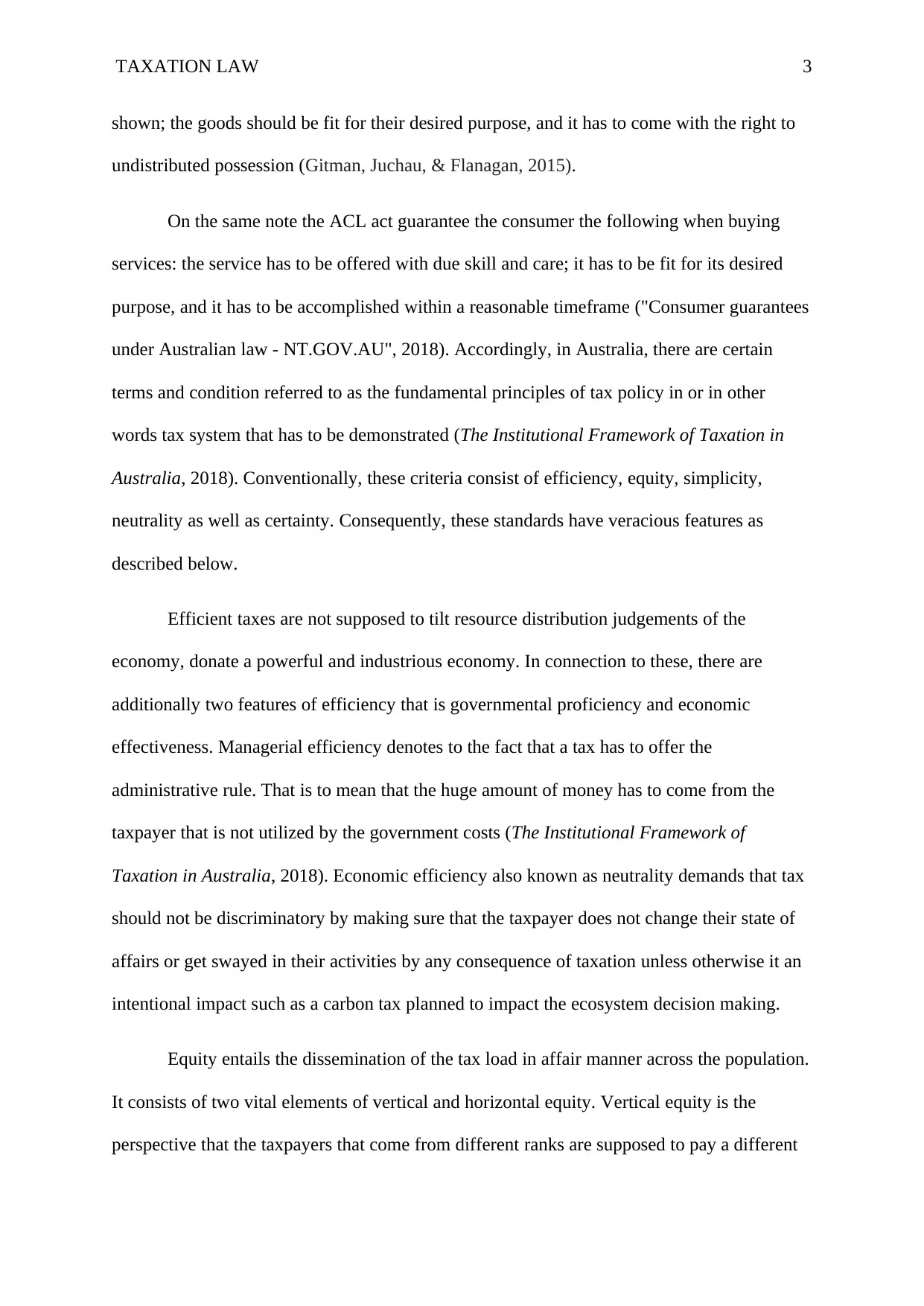
TAXATION LAW 3
shown; the goods should be fit for their desired purpose, and it has to come with the right to
undistributed possession (Gitman, Juchau, & Flanagan, 2015).
On the same note the ACL act guarantee the consumer the following when buying
services: the service has to be offered with due skill and care; it has to be fit for its desired
purpose, and it has to be accomplished within a reasonable timeframe ("Consumer guarantees
under Australian law - NT.GOV.AU", 2018). Accordingly, in Australia, there are certain
terms and condition referred to as the fundamental principles of tax policy in or in other
words tax system that has to be demonstrated (The Institutional Framework of Taxation in
Australia, 2018). Conventionally, these criteria consist of efficiency, equity, simplicity,
neutrality as well as certainty. Consequently, these standards have veracious features as
described below.
Efficient taxes are not supposed to tilt resource distribution judgements of the
economy, donate a powerful and industrious economy. In connection to these, there are
additionally two features of efficiency that is governmental proficiency and economic
effectiveness. Managerial efficiency denotes to the fact that a tax has to offer the
administrative rule. That is to mean that the huge amount of money has to come from the
taxpayer that is not utilized by the government costs (The Institutional Framework of
Taxation in Australia, 2018). Economic efficiency also known as neutrality demands that tax
should not be discriminatory by making sure that the taxpayer does not change their state of
affairs or get swayed in their activities by any consequence of taxation unless otherwise it an
intentional impact such as a carbon tax planned to impact the ecosystem decision making.
Equity entails the dissemination of the tax load in affair manner across the population.
It consists of two vital elements of vertical and horizontal equity. Vertical equity is the
perspective that the taxpayers that come from different ranks are supposed to pay a different
shown; the goods should be fit for their desired purpose, and it has to come with the right to
undistributed possession (Gitman, Juchau, & Flanagan, 2015).
On the same note the ACL act guarantee the consumer the following when buying
services: the service has to be offered with due skill and care; it has to be fit for its desired
purpose, and it has to be accomplished within a reasonable timeframe ("Consumer guarantees
under Australian law - NT.GOV.AU", 2018). Accordingly, in Australia, there are certain
terms and condition referred to as the fundamental principles of tax policy in or in other
words tax system that has to be demonstrated (The Institutional Framework of Taxation in
Australia, 2018). Conventionally, these criteria consist of efficiency, equity, simplicity,
neutrality as well as certainty. Consequently, these standards have veracious features as
described below.
Efficient taxes are not supposed to tilt resource distribution judgements of the
economy, donate a powerful and industrious economy. In connection to these, there are
additionally two features of efficiency that is governmental proficiency and economic
effectiveness. Managerial efficiency denotes to the fact that a tax has to offer the
administrative rule. That is to mean that the huge amount of money has to come from the
taxpayer that is not utilized by the government costs (The Institutional Framework of
Taxation in Australia, 2018). Economic efficiency also known as neutrality demands that tax
should not be discriminatory by making sure that the taxpayer does not change their state of
affairs or get swayed in their activities by any consequence of taxation unless otherwise it an
intentional impact such as a carbon tax planned to impact the ecosystem decision making.
Equity entails the dissemination of the tax load in affair manner across the population.
It consists of two vital elements of vertical and horizontal equity. Vertical equity is the
perspective that the taxpayers that come from different ranks are supposed to pay a different
⊘ This is a preview!⊘
Do you want full access?
Subscribe today to unlock all pages.

Trusted by 1+ million students worldwide
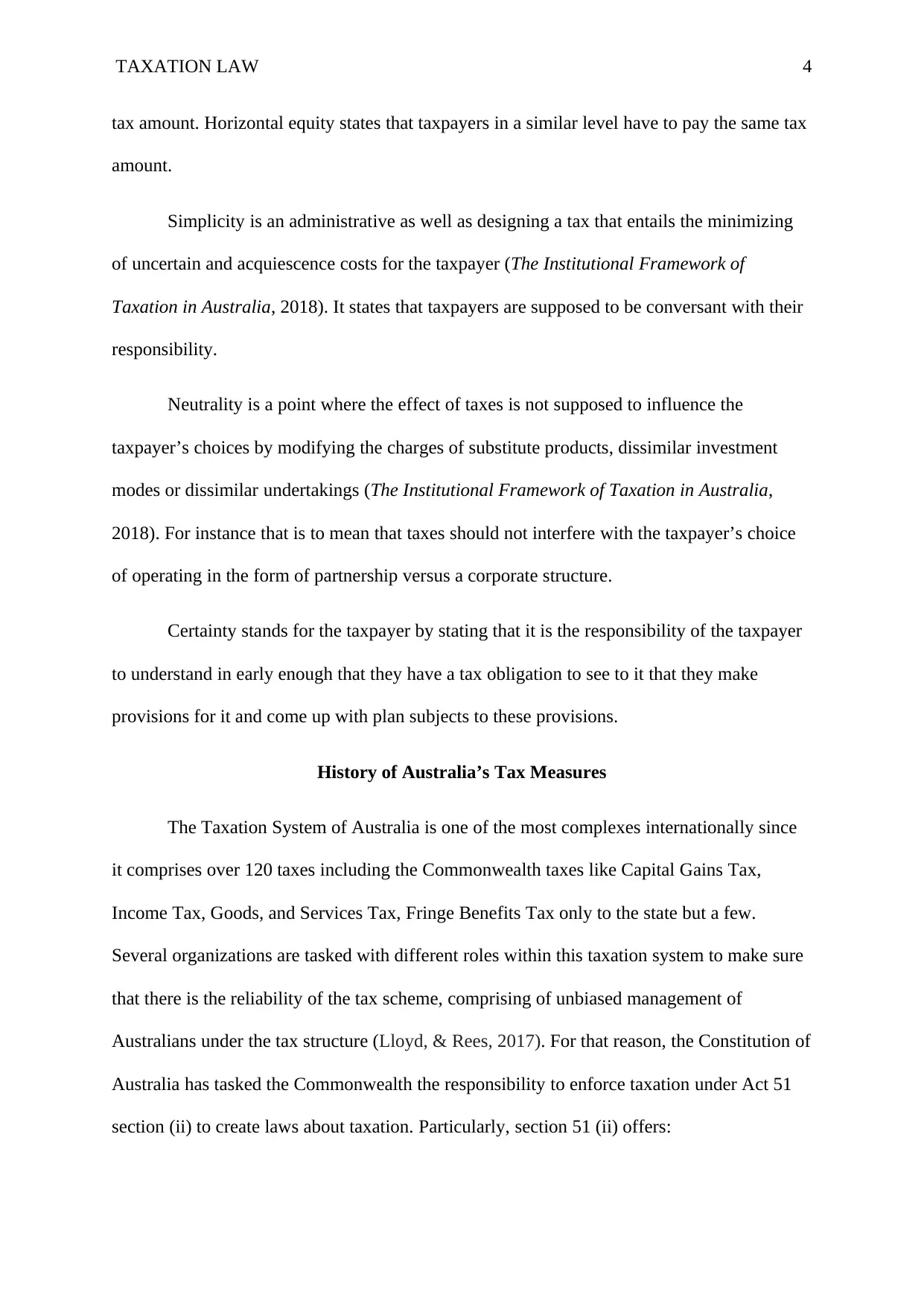
TAXATION LAW 4
tax amount. Horizontal equity states that taxpayers in a similar level have to pay the same tax
amount.
Simplicity is an administrative as well as designing a tax that entails the minimizing
of uncertain and acquiescence costs for the taxpayer (The Institutional Framework of
Taxation in Australia, 2018). It states that taxpayers are supposed to be conversant with their
responsibility.
Neutrality is a point where the effect of taxes is not supposed to influence the
taxpayer’s choices by modifying the charges of substitute products, dissimilar investment
modes or dissimilar undertakings (The Institutional Framework of Taxation in Australia,
2018). For instance that is to mean that taxes should not interfere with the taxpayer’s choice
of operating in the form of partnership versus a corporate structure.
Certainty stands for the taxpayer by stating that it is the responsibility of the taxpayer
to understand in early enough that they have a tax obligation to see to it that they make
provisions for it and come up with plan subjects to these provisions.
History of Australia’s Tax Measures
The Taxation System of Australia is one of the most complexes internationally since
it comprises over 120 taxes including the Commonwealth taxes like Capital Gains Tax,
Income Tax, Goods, and Services Tax, Fringe Benefits Tax only to the state but a few.
Several organizations are tasked with different roles within this taxation system to make sure
that there is the reliability of the tax scheme, comprising of unbiased management of
Australians under the tax structure (Lloyd, & Rees, 2017). For that reason, the Constitution of
Australia has tasked the Commonwealth the responsibility to enforce taxation under Act 51
section (ii) to create laws about taxation. Particularly, section 51 (ii) offers:
tax amount. Horizontal equity states that taxpayers in a similar level have to pay the same tax
amount.
Simplicity is an administrative as well as designing a tax that entails the minimizing
of uncertain and acquiescence costs for the taxpayer (The Institutional Framework of
Taxation in Australia, 2018). It states that taxpayers are supposed to be conversant with their
responsibility.
Neutrality is a point where the effect of taxes is not supposed to influence the
taxpayer’s choices by modifying the charges of substitute products, dissimilar investment
modes or dissimilar undertakings (The Institutional Framework of Taxation in Australia,
2018). For instance that is to mean that taxes should not interfere with the taxpayer’s choice
of operating in the form of partnership versus a corporate structure.
Certainty stands for the taxpayer by stating that it is the responsibility of the taxpayer
to understand in early enough that they have a tax obligation to see to it that they make
provisions for it and come up with plan subjects to these provisions.
History of Australia’s Tax Measures
The Taxation System of Australia is one of the most complexes internationally since
it comprises over 120 taxes including the Commonwealth taxes like Capital Gains Tax,
Income Tax, Goods, and Services Tax, Fringe Benefits Tax only to the state but a few.
Several organizations are tasked with different roles within this taxation system to make sure
that there is the reliability of the tax scheme, comprising of unbiased management of
Australians under the tax structure (Lloyd, & Rees, 2017). For that reason, the Constitution of
Australia has tasked the Commonwealth the responsibility to enforce taxation under Act 51
section (ii) to create laws about taxation. Particularly, section 51 (ii) offers:
Paraphrase This Document
Need a fresh take? Get an instant paraphrase of this document with our AI Paraphraser
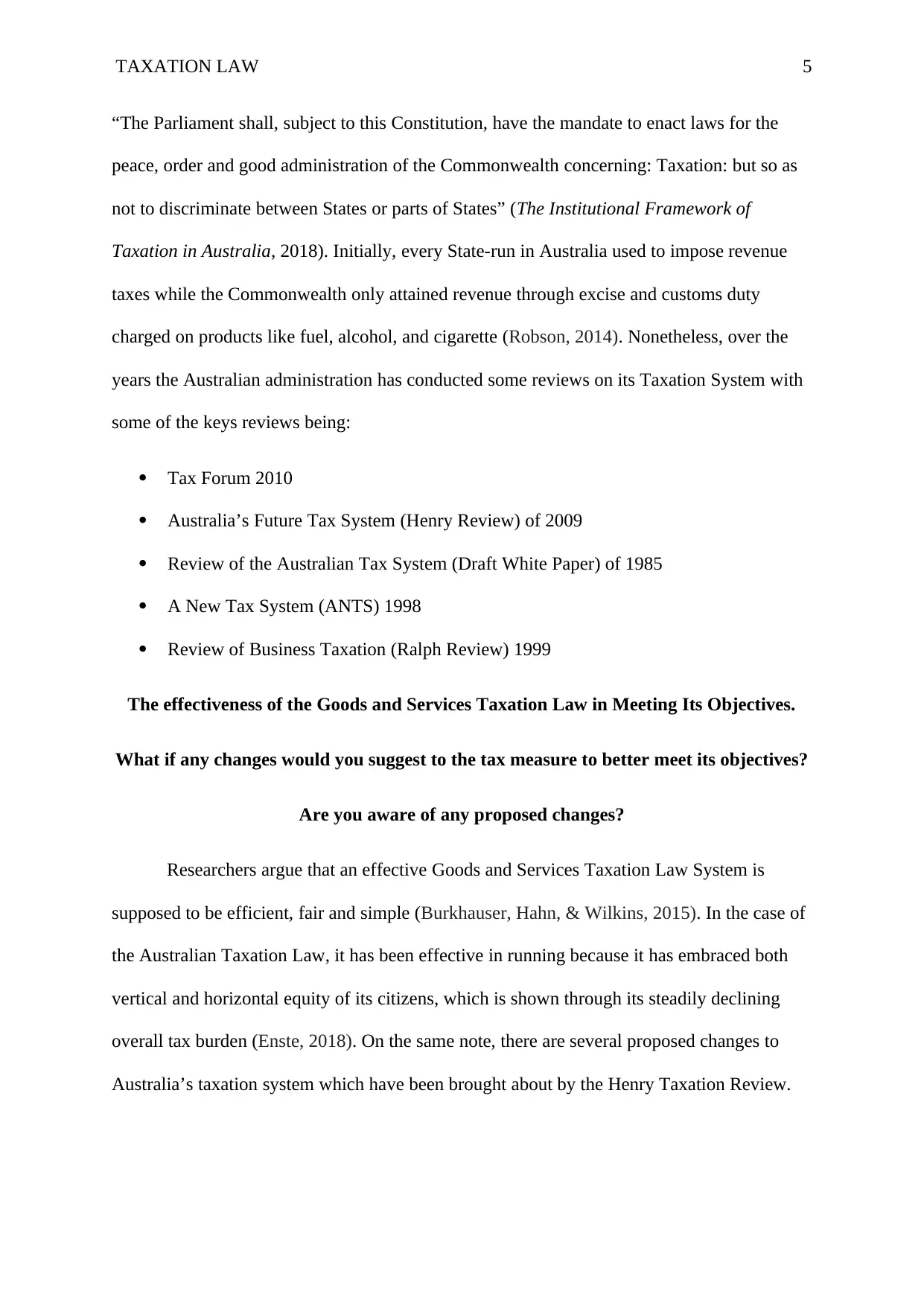
TAXATION LAW 5
“The Parliament shall, subject to this Constitution, have the mandate to enact laws for the
peace, order and good administration of the Commonwealth concerning: Taxation: but so as
not to discriminate between States or parts of States” (The Institutional Framework of
Taxation in Australia, 2018). Initially, every State-run in Australia used to impose revenue
taxes while the Commonwealth only attained revenue through excise and customs duty
charged on products like fuel, alcohol, and cigarette (Robson, 2014). Nonetheless, over the
years the Australian administration has conducted some reviews on its Taxation System with
some of the keys reviews being:
Tax Forum 2010
Australia’s Future Tax System (Henry Review) of 2009
Review of the Australian Tax System (Draft White Paper) of 1985
A New Tax System (ANTS) 1998
Review of Business Taxation (Ralph Review) 1999
The effectiveness of the Goods and Services Taxation Law in Meeting Its Objectives.
What if any changes would you suggest to the tax measure to better meet its objectives?
Are you aware of any proposed changes?
Researchers argue that an effective Goods and Services Taxation Law System is
supposed to be efficient, fair and simple (Burkhauser, Hahn, & Wilkins, 2015). In the case of
the Australian Taxation Law, it has been effective in running because it has embraced both
vertical and horizontal equity of its citizens, which is shown through its steadily declining
overall tax burden (Enste, 2018). On the same note, there are several proposed changes to
Australia’s taxation system which have been brought about by the Henry Taxation Review.
“The Parliament shall, subject to this Constitution, have the mandate to enact laws for the
peace, order and good administration of the Commonwealth concerning: Taxation: but so as
not to discriminate between States or parts of States” (The Institutional Framework of
Taxation in Australia, 2018). Initially, every State-run in Australia used to impose revenue
taxes while the Commonwealth only attained revenue through excise and customs duty
charged on products like fuel, alcohol, and cigarette (Robson, 2014). Nonetheless, over the
years the Australian administration has conducted some reviews on its Taxation System with
some of the keys reviews being:
Tax Forum 2010
Australia’s Future Tax System (Henry Review) of 2009
Review of the Australian Tax System (Draft White Paper) of 1985
A New Tax System (ANTS) 1998
Review of Business Taxation (Ralph Review) 1999
The effectiveness of the Goods and Services Taxation Law in Meeting Its Objectives.
What if any changes would you suggest to the tax measure to better meet its objectives?
Are you aware of any proposed changes?
Researchers argue that an effective Goods and Services Taxation Law System is
supposed to be efficient, fair and simple (Burkhauser, Hahn, & Wilkins, 2015). In the case of
the Australian Taxation Law, it has been effective in running because it has embraced both
vertical and horizontal equity of its citizens, which is shown through its steadily declining
overall tax burden (Enste, 2018). On the same note, there are several proposed changes to
Australia’s taxation system which have been brought about by the Henry Taxation Review.
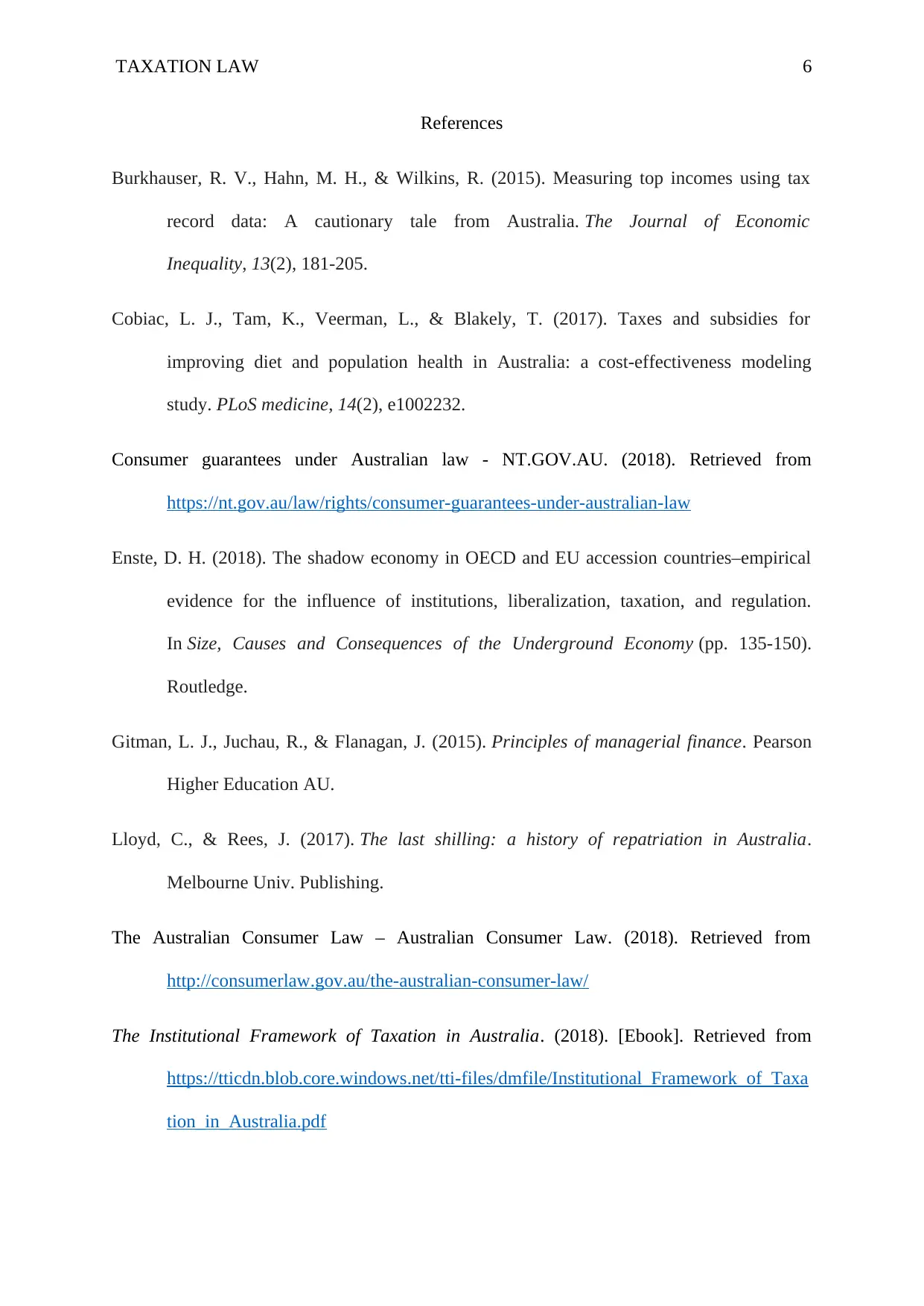
TAXATION LAW 6
References
Burkhauser, R. V., Hahn, M. H., & Wilkins, R. (2015). Measuring top incomes using tax
record data: A cautionary tale from Australia. The Journal of Economic
Inequality, 13(2), 181-205.
Cobiac, L. J., Tam, K., Veerman, L., & Blakely, T. (2017). Taxes and subsidies for
improving diet and population health in Australia: a cost-effectiveness modeling
study. PLoS medicine, 14(2), e1002232.
Consumer guarantees under Australian law - NT.GOV.AU. (2018). Retrieved from
https://nt.gov.au/law/rights/consumer-guarantees-under-australian-law
Enste, D. H. (2018). The shadow economy in OECD and EU accession countries–empirical
evidence for the influence of institutions, liberalization, taxation, and regulation.
In Size, Causes and Consequences of the Underground Economy (pp. 135-150).
Routledge.
Gitman, L. J., Juchau, R., & Flanagan, J. (2015). Principles of managerial finance. Pearson
Higher Education AU.
Lloyd, C., & Rees, J. (2017). The last shilling: a history of repatriation in Australia.
Melbourne Univ. Publishing.
The Australian Consumer Law – Australian Consumer Law. (2018). Retrieved from
http://consumerlaw.gov.au/the-australian-consumer-law/
The Institutional Framework of Taxation in Australia. (2018). [Ebook]. Retrieved from
https://tticdn.blob.core.windows.net/tti-files/dmfile/Institutional_Framework_of_Taxa
tion_in_Australia.pdf
References
Burkhauser, R. V., Hahn, M. H., & Wilkins, R. (2015). Measuring top incomes using tax
record data: A cautionary tale from Australia. The Journal of Economic
Inequality, 13(2), 181-205.
Cobiac, L. J., Tam, K., Veerman, L., & Blakely, T. (2017). Taxes and subsidies for
improving diet and population health in Australia: a cost-effectiveness modeling
study. PLoS medicine, 14(2), e1002232.
Consumer guarantees under Australian law - NT.GOV.AU. (2018). Retrieved from
https://nt.gov.au/law/rights/consumer-guarantees-under-australian-law
Enste, D. H. (2018). The shadow economy in OECD and EU accession countries–empirical
evidence for the influence of institutions, liberalization, taxation, and regulation.
In Size, Causes and Consequences of the Underground Economy (pp. 135-150).
Routledge.
Gitman, L. J., Juchau, R., & Flanagan, J. (2015). Principles of managerial finance. Pearson
Higher Education AU.
Lloyd, C., & Rees, J. (2017). The last shilling: a history of repatriation in Australia.
Melbourne Univ. Publishing.
The Australian Consumer Law – Australian Consumer Law. (2018). Retrieved from
http://consumerlaw.gov.au/the-australian-consumer-law/
The Institutional Framework of Taxation in Australia. (2018). [Ebook]. Retrieved from
https://tticdn.blob.core.windows.net/tti-files/dmfile/Institutional_Framework_of_Taxa
tion_in_Australia.pdf
⊘ This is a preview!⊘
Do you want full access?
Subscribe today to unlock all pages.

Trusted by 1+ million students worldwide

TAXATION LAW 7
Robson, A. (2014). Australia's carbon tax: An economic evaluation. Economic Affairs, 34(1),
35-45.
Robson, A. (2014). Australia's carbon tax: An economic evaluation. Economic Affairs, 34(1),
35-45.
Paraphrase This Document
Need a fresh take? Get an instant paraphrase of this document with our AI Paraphraser

TAXATION LAW 8
1 out of 8
Related Documents
Your All-in-One AI-Powered Toolkit for Academic Success.
+13062052269
info@desklib.com
Available 24*7 on WhatsApp / Email
![[object Object]](/_next/static/media/star-bottom.7253800d.svg)
Unlock your academic potential
Copyright © 2020–2025 A2Z Services. All Rights Reserved. Developed and managed by ZUCOL.





